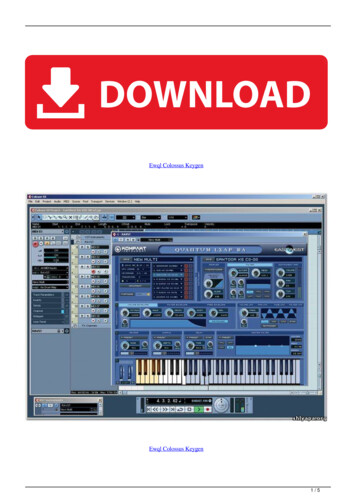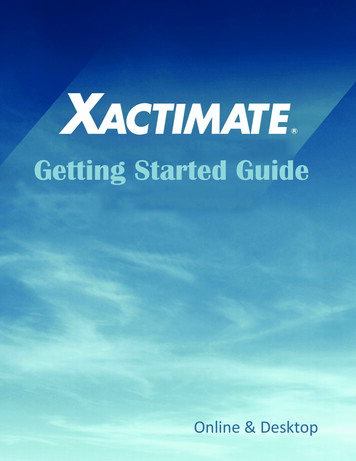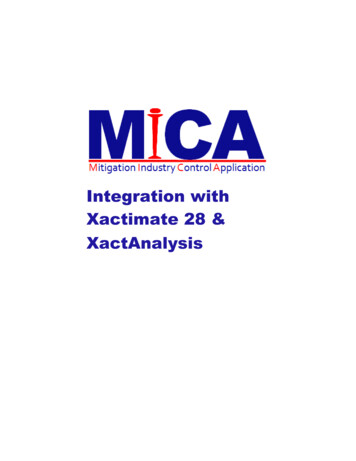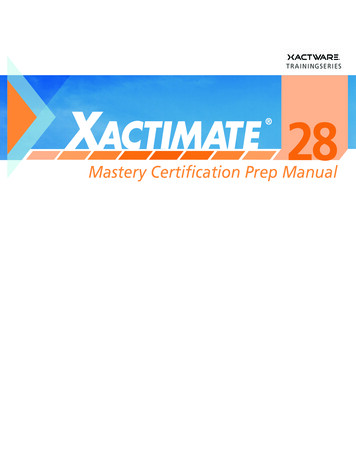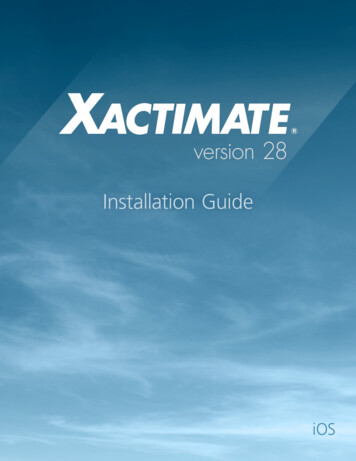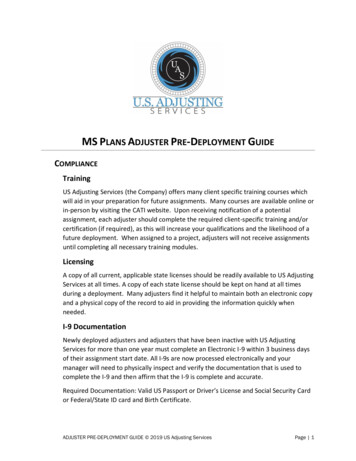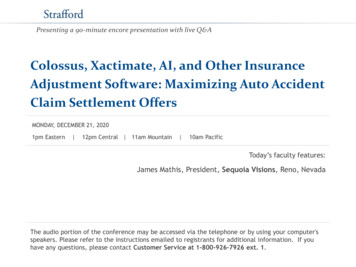
Transcription
Presenting a 90-minute encore presentation with live Q&AColossus, Xactimate, AI, and Other InsuranceAdjustment Software: Maximizing Auto AccidentClaim Settlement OffersMONDAY, DECEMBER 21, 20201pm Eastern 12pm Central 11am Mountain 10am PacificToday’s faculty features:James Mathis, President, Sequoia Visions, Reno, NevadaThe audio portion of the conference may be accessed via the telephone or by using your computer'sspeakers. Please refer to the instructions emailed to registrants for additional information. If youhave any questions, please contact Customer Service at 1-800-926-7926 ext. 1.
2020Colossus & Other Programs inAuto Accident Claim RecoveryStrafford WebinarsPresented by:James J. MathisCopyright @ 2002 & 2007 & 2010
Now Available For Sequoia Customers OnlyR.O.E.Phone: (281) 674-7174Fax: (888) 363-1776The Trauma ExpertsCOMPREHENSIVE POST-TRAUMATIC INJURY SCREENINGThrough the use of National Telemedicine interviews and record review. MECHANISM AND CAUSALITY OF ALL INJURIESPOST-INJURY SYMPTOMSCLINICAL INDICIA OF MILD TRAUMATIC BRAIN INJURY MTBIRESULTS OF NEUROLOGICAL SCREENINGRESULTS OF ORTHOPEDIC SCREENINGRESULTS OF PSYCHOLOGICAL SCREENINGIMPAIRED ACTIVITIES OF DAILY LIVING DUE TO THEACCIDENTPOTENTIAL INJURIES & CONDITIONSPOTENTIAL DIAGNOSTICSPOTENTIAL REFERRALSGENERALIZED ANXIETY DISORDER 7-ITEM (GAD-7) SCALETHE PTSD CHECKLIST (PCL-5) SF-20This is all presented in a multiple page report signed by a medical physician.1
I N D E XRISE OF COLOSSUS3PROFIT IN THE CLAIMS DEPARTMENT9BUILDING THE CLAIM19ICD-9 TO ICD-10 CONVERSION TABLE23COLOSSUS APPLICATION OF IMPAIRMENT25PREPARING THE DEMAND AND NEGOTIATION48PROGRAM FOR EVALUATION57NON COLOSSUS CLAIMS62INSURANCE INDUSTRY APPLICATION OF COLOSSUS65MIST69CHIROPRACTIC CARE & QUICK REVIEW81HOW TO PREPARE A CLAIM85CLAIM REVIEW WORKSHEET87SUPPLEMENTAL HCFA FORM91DOG BITE SCARRING OR DEFORMATION DEMAND PREPARATION92IMPAIRMENT & DUD/LOE96SEQUOIA ORDER FORM – DEMAND ONLINE & MEDICAL SUITE162CV - JAMES J. MATHIS101SAMPLE DEMAND110SAMPLE MEDICAL REPORT120PERSONAL INJURY UNIVERSITY SYLLABUS135ATTENDEE EVALUATION FORM136ADDENDUM – CPT CODES137ADDENDUM - CONVERSION ICD-9 TO 10 WITH COMPLAINTS1392019 ADDENDUM UPDATED CODINGS156BODYSHOP QUESTIONAIRE164DUD/LOE WORKSHEET166MEDICAL SUMMARY FORM168DEMAND ONLINE FUNCTIONS & ORDER FORM1692
R I S EO FC O L O S S U SBy James J. Mathis 1PREFACEThe business of insurance has been around for a very long time. The first contract ofinsurance I could find was signed in Genoa in circa 1347. Insurance contracts were entered intoby individuals, either alone or in a group. They each wrote their name and the amount of riskthey were willing to assume under the insurance proposal. In Babylonia, traders assumed therisks of the caravan trade through loans that were repaid after the goods had arrived safely—apractice resembling bottomry and given legal force in the Code of Hammurabi (c.2100 B.C.).Hence, the term Underwriter. In the United States. the history of insurance involves twoprinciples: risk protection and capital accumulation. Originally, underwriters, usually merchantsand real‐estate men who could assess risk and estimate profitable premium rates, insuredpolicyholders for lost cargoes and the destruction of buildings by fire. Risk is now calculated byprofessional actuaries using complex statistical techniques.The Merriam-Webster Dictionary describes insurance as, “coverage by contract wherebyone party undertakes to indemnify or guarantee another against loss by a specified contingencyor peril.” So the basis of insurance is “guarantee against loss”. Insurance can be considered tobe a transfer of a future risk in exchange for a paid premium. Each policyholder pays apremium to their selected insurer with the promise from the insurer that the future economicexposures up to an agreed limit from a covered loss will be assumed by the insurer with theexception of any deductible or co-payment previously stipulated in the insurance contract.Essentially, a transfer of risk is paid for by the policyholder and assumed by the insurer.Payment for the assumed risk by the insurer on behalf of the policyholder can beseparated into two types of claims. A first party claim involves those risks paid directly to thepolicyholder (or any other party considered a policyholder). For example, collision,comprehensive, MPC (Medical Payment Coverage), PIP (Personal Injury Protection), Uninsuredand Underinsured losses would all be first party claims. Third party claims are those risks paidto a party who has suffered a loss which the policyholder may be found to be negligent incausing. Since, this represents an economic risk to the policyholder and assuming thepolicyholder has contracted with the insurer for Liability coverage, the insurer assumes the costof that economic risk (including any cost of investigation, analysis, resolution and legal defenseof the policyholder should litigation occur).Most states hold that a fiduciary responsibility exists either implicitly or explicitlybetween the policyholder and the insurer. Almost all states have adopted the Fair Claims Actinto their statutes defining what is required of the insurer in the handling of first party claims.Only a few states have adopted the Fair Claims Act in their statutes where the claim is handledby the insurer as a third party claim. Where a duty or fiduciary responsibility under theindividual state’s statutes has not been completed or has been violated, it could then be definedas an act of “Bad Faith” or “Breach of Contract”. In some cases, this has led to a lawsuitbrought by the policyholder against the insurer.1CV of James J. Mathis is in the back of this handout.3
When the risk or claim involves damages to a third party, not a policyholder, which thepolicyholder will be found responsible for, the insurer has a duty to assume the cost of thosedamages (up the limit of the coverage contracted by the policyholder). If the insurer fails toresolve the third party claim within the limits of the policy, when it had an opportunity to, theinsurer can be found have failed its fiduciary responsibility, breached its contract and/orcommitted an act of bad faith. Under this circumstance the third party may filed a suit againstthe policyholder to recover all damages as a result of the policyholder’s negligence. Should thelawsuit result in a judgement in excess of the policy limits, the policyholder can choose to assignto the third party the right to bring a lawsuit against the insurer for the breach of contract and/orthe act of bad faith.THE LEGAL ENVIRONMENT TODAYHere is a general history of the environment, which exists between the legal community and theinsurance industry. When an individual was involved in an accident where they were injured,they would seek medical treatment for their injuries (medical specials). They might lose sometime from their employment as well (income loss or economic specials). They could also havefuture needs for medical treatment and possibly future periods of income loss. They might alsohave permanent impairment or disabilities.When the treatment was completed and their injuries were resolved, they would approach theinsurance company adjuster to settle their claim. The injured party might perform this through aretained attorney as well. The claim would be evaluated by the adjuster utilizing his/herexperience, training, education, and common sense. The claim, which was evaluated, consistedof medical specials, economic specials (medical treatment costs and income loss) and “pain andsuffering”. “Pain and suffering” are dollars paid for the inconvenience of the accident, injuriesand consequences of the accident. The adjuster would understand the inherent issues associatedwith these claims. A claim would result in a settlement of approximately three to four timesspecials. This meant that a claimant with 3,000.00 in specials would most likely receive asettlement offer from the insurance adjuster of 9,000.00 to 12,000.00. This is assuming therewere no unusual circumstances involved in the claim.At some point in the late 80’s and during the early 90’s, the insurance industry determined thatthere was an opportunity to realize a profit in their claims departments by paying less for claims.The fact became obvious that only a small percentage of any attorney’s clients’ claims couldactually be taken to suit and ultimately to judgment. So, if an attorney had one hundred clients,the attorney could probably only file suit and pursue that suit to judgment on 2 to 5 of his clients’claims. This would mean at least 95 of the attorney’s 100 clients’ claims would be resolved atwhatever settlement offer the insurer determined. Also, of the 2 to 5 claims taken to judgment,the insurer could very well succeed in realizing a judgment in its favor.Therefore, the most financially successful strategy for the insurance industry was to simply lowball every claim with the sole exception of those claims which might have obvious value inexcess of the policy limits. Any claim which had the slightest defense available for the insurer(i.e. MINOR IMPACT – low property repair estimates, comparative negligence, contributorynegligence, causation issues, excessive treatment billing, excessive treatment duration, frequencyor type, questionable injury diagnosis, multiple defendants, etc.) would be evaluated at a lowsettlement value. After a delay from the time a demand was received from the attorney on behalfof a client, an unreasonably low offer (IFO – Initial First Offer) would usually be extended toresolve the claim. The attorney would either counter this or file a lawsuit. If the attorney4
countered the offer rather than filing a lawsuit, a second offer (only nominally increased from theIFO) would be extended by the insurer as a final offer (FO – Final Offer). The insurer wouldalso advise the attorney, that if the settlement offer was not acceptable, the attorney should file alawsuit. Thereby, inviting litigation to be brought against its insured (considered to be a badfaith act in some states). Again, the insurer is playing the odds that the attorney would not beable to take the lawsuit to judgment.If 80 percent of the claims presented to the insurer fell into the category of the claim asdescribed in the previous paragraph, and if those same injured parties were willing to pay anattorney 33.3 percent of their settlement dollars to deal with the insurance industry for them, thenwhy couldn’t the insurance industry make the allegation that 6,000.00 inclusive of the specialswas a fair settlement value of the claim? ( 3,000.00 X 3 9,000.00; 9,000.00 X 33 1/3% 3,000.00; 9,000.00— 3,000.00 6,000.00)This analysis would lead to the insurance industry significantly reducing settlement offers to allparties. They determined only 20 percent of the public would actually retain an attorney. Theyassumed that of that 20 percent, 80 percent would settle for the claim in the insurance industry’srange of settlement (Even at the new low figure). They anticipated that the percent of lawsuitswould increase, but the cost to defend those was negligible compared to the profits generated bythe decrease in claim dollars paid out. The net effect was significant on the bottom line profitrealized by the insurance industry from the mid 1990s continuing through the present.The case reserve 2 in 1990 for a soft tissue injury liability claim was approximately 15,800.00.The case reserve for the same type of injury in 2001 was approximately 5,800.00. Thisreduction in claim severity was a direct result of the changed process and programs such as“MIST”, “Minor Impact” and “No Damage/No Injury”. This 10,000.00 savings per claim has adirect impact the profits realized from the claim department. Considering that State Farm ClaimVice President 3 recently stated in deposition State Farm experiences 15,000 claim per day.While only thirty percent of this number would represent the number of automobile claimsexperiencing the decrease in claim severity, the number is still a staggering 5,000. Multiplyingthat number by the number of days in a year equals 1,825,000. Realizing a savings of 10,000.00 claim payout per claim, this would represent an annual savings of 1,825,000,000.This dollar amount of savings in claim payouts multiplied by the total number of insurers wouldbe a staggering annual dollar figure not being paid out to the general public in reasonablesettlements. It might be an eye opening exercise to have some economist actually extrapolate thedirect and indirect economic impact on the public over the last fifteen years.THE MEDICAL COMMUNITY ENVIRONMENTThe Insurance Industry claim handling culture went through a major transformation during themid 1990’s adopting the opinions and advice of McKinsey Consulting. This was accomplishedby each individual insurer in conjunction with McKinsey Consulting (Arthur Anderson orAccenture as it is currently known, also contributed to some insurers’ transformation) throughthe creation and implementation of the McKinsey “Business Process Improvement” (BPI)culture. This transformation of claim culture is evident in the McKinsey documents Allstate hasThis is the amount of dollars set aside by the insurer in anticipating the amount to paid on this type claim atsettlement. The figure is based on a three year historical severity realized by the insurer.3Fowler vs. State Farm Mutual Automobile Insurance Company, Hawaii; The United States DistrictCourt For the District of Hawaii; Civil No. CV07 00071 SPK/KSC;25
produced in other cases across the country 4. There no longer exists, if there ever did, aproprietary or confidential nature concerning these documents. Similarly, since Allstate haspreviously produced these same documents in their production as required by the courts in otherlitigation, it cannot now claim to this court that the requests would be overly burdensome orrequire unreasonable time to produce.These Allstate/McKinsey and CCPR documents fully describe the current culture in theinsurance industry including Allstate’s culture, to target individual treating facilities orpractitioners. The targeted facility would generally have a large patient count with a significantpresence of minority patients. The target facility or practitioner would have a history oftestifying on behalf of their patients’ injuries. In most cases the targets have been well respectedin the medical community in which they practice. These targeted facilities and practitionerswould then find themselves the object of a SIU (Special Investigation Unit) or Fraud Unitintensive investigation during which time all payments to the facility would be put “on hold”.The information that this facility or practitioner was identified as a target would be disseminatedthroughout the insurance industry, resulting in other insurers placing all payments “on hold”.During this time of harassment by the insurance industry, naturally, patient numbers woulddramatically reduce. Ultimately, an opportunity would be extended to the facility or practitionerto pay back disputed charges paid by the insurer or, in some cases, a suit against that facility orpractitioner would be brought by the insurer alleging fraud. In other situations, a “Request forProsecution” document is created and submitted to the local District Attorney’s office forcriminal prosecution 5.This practice by the insurance industry has a direct impact on the entire medical community inthe geographic area in which it is executed. The insurance industry experiences an even moreextensive secondary benefit by other Chiropractic facilities or practitioners in the geographicregion reducing the number of automobile patients accepted, reducing the duration, type orfrequency of treatment to automobile patients and/or reducing the amount in which is billed forthat treatment. The insurance industry has taken the next step with programs such as StateFarm’s “Minor Impact”, Farmer’s “No Damage, No Injury” and Allstate’s “MIST (Minor ImpactSoft Tissue), in which the insurer is stating that based on the small amount of property damage 6,there can be no injury and therefore, no treatment costs.This culture is being driven by a very basic pursuit of profits by the insurance industry. Allstatereceives tens of thousands claims presented to it each day. The current industry percentage ofthese claims which would involve “soft tissue” injuries varies between 85 and 90 percent. Themost common treating facility or practitioner sought for the treatment of “soft tissue” injuries isChiropractic. The current industry percentage of Chiropractic involvement in these types ofclaims is as high as 95%. Most of the injured parties have either PIP/MPC benefits available topay for the treatment. A very significant number of the injured parties also have either thirdparty claims against an insured negligent tortfeasor or a first party claim under their UM/UIM(Uninsured Motorist/Underinsured Motorist) coverages.This reasonably reflects an enormous exposure to the insurance industry as first or third partyclaim severities as well as one of the most significant obstacles to the insurance industry’spursuit of profits. McKinsey introduced the simple concept of creating profits within the claimsection of an insurer by simply utilizing those tools available to reduce or deny claim payments.(See the listing of cases involving this issue as an endnote to this section)The People of The State of California vs. Wilmer Origel, Superior Court of California, County of San Joaquin;No SFO94494A;6Allstate’s threshold was recently established at 1,500.00 or less in repair estimates to the vehicle.645
By eliminating the Chiropractic diagnosis of injuries and complaints of injured the parties andreducing or eliminating entirely the medical cost of treatment to those individuals, claimseverities would decrease dramatically. This decrease would be realized in the area of greatestexposure to the insurance industry (soft tissue claims). If an insurer is experiencing 16,000claims a day, ninety five percent of ninety percent of that number is 13,680 claims.When Allstate instituted this culture (McKinsey/CCPR/MIST) of attacking Chiropractictreatment and “soft tissue” injuries, it then realized a claim payout savings that is continuing toincrease today. Almost all of the claim files which I reviewed in this matter involved propertydamage repair costs under 1,500.00. The average claim cost of 15,000 per claim experiencedin 1990 through 2000 dropped by as much as two-thirds. A claim savings of 10,000.00 perclaim multiplied by 13,680 claims represents 13,680,000.00 in claim payout savings (Profit) peryear. As of 2000 the insurance industry began to experience a reduction of claim frequency(fewer claims were being reported or accepted) while the claim severity began to increase 7. Thereduction in frequency is in part due to safer vehicles and in part due to the insurance industryculture changes. The increase in severity is the motivator for the insurance industry’s moreaggressive change in claim culture (State Farm Insurance Company’s “Minor Impact Defense”,Farmers Insurance Company’s “No Damage No Injury” and Allstate Insurance Company’s“MIST” Programs) and its attack on the Chiropractic community.ENDNOTE: LISTING OF APPLICABLE CASESAllstate Ins. Co. v. Fields, 842 N.E.2d 804 (Ind. 2006)., Allstate Ins. Co. v. Fields, 831 N.E.2d 750 (Ind. 2005), DaleDeer vs. Allstate Insurance Company and Paul Jason Aldridge, In the Circuit Court of Jackson County, Missouri, atIndependence, Case No. 0516-CV24031, Hensel, Individually and as Class Representative vs. Allstate InsuranceCompany, Allstate Indemnity Company, Gary Davis and Tina Watts; Alaska; In the Superior Court for The State ofAlaska, Third Judicial District; Case No. 3AN-02-7154 CI;; Martinez vs. Davis, New Mexico; The State of NewMexico, County of Bernalillo Second Judicial District Court; Case No. CV 99-07598; McCallum vs. AllstateProperty and Casualty Insurance Company, Washington; In the Court of Appeals of The State of Washington,Division II; (Pierce Co. Superior Court No. 06-2-09493-5); Allstate vs. Scroghan, In The Court of Appeals ofIndiana; No. 03A04-0410-CV-554, Camus vs. State Farm Mutual Automobile Insurance; Colorado; El PasoCounty, CO, District Court 4th JD; Case Number: 05CV404; Armisted, et al v. State Farm Mutual AutomobileInsurance Company, Michigan; United States District Court, Eastern District of Michigan, Southern Division; CivilAction No. 07-10259; Simonsen vs. Allstate, Montana; The United States District Court for the District of Montana,Butte Division; CV-01-64-BU-DWM; Hutt vs. State Farm Mutual Automobile Insurance Company, Pennsylvania;Court of Common Pleas, Philadelphia County; NO. 000176; Berry vs. Allstate Insurance Company, Michigan;United States District Court, Eastern District of Michigan, Southern Division; Case No. 2:07-CV-14627; Burger vs.Allstate Insurance Company, Michigan; State of Michigan in the Circuit Court for the County of Wayne; Doan vs.Allstate Insurance Company, Michigan; United States district Court, Eastern District of Michigan, SouthernDivision; Case No. 5:07-cv-13957; Van Emon vs. State Farm Mutual Automobile Company, Michigan, Unites StatesDistrict Court For the Eastern District of Michigan, Southern Division; Case No.: 05-CV-72638; State FarmMutual Automobile Insurance Company and State Farm Fire and Casualty Company vs. Robert J. Cavoto, Jr.,Fishbone Advertising, Inc. Cavoto Chiropractors, P.C., Margaret Fisher-Catrabone, Penn Center painmanagement, Inc., Tiprof, Inc. and International Health Alliance, Inc., Court of Common Pleas Delaware County,No. 05-10716; Lynch vs. State Farm Mutual Automobile Insurance Company, Nebraska; The District Court ofDouglas County, Nebraska; Case No. DOC. 980 NO. 654; Hill vs. State Farm Mutual Automobile InsuranceCompany, Oklahoma; The United States District Court for The Western District of Oklahoma; Case No. CIV-001877-T; Sitton vs. State Farm, Washington; Superior Court of Washington for King County; Case No. 00-2-10013;Plateros vs. State Farm Mutual Automobile Insurance Company, Nevada; The Second Judicial District Court of theState of Nevada in and for The County of Washoe; Case No. CV98-07605; Quynh Truong, et al. vs. AllstateInsurance Company, et al., New Mexico; Watkins vs. State Farm Fire & Casualty Company, Oklahoma; In TheDistrict Court of Grady County, State of Oklahoma; Case No. CJ-2000-303; Hernandez v. Allstate InsuranceCompany, Washington; King County, Washington; Cause No. 05-2-005891-9 SEA; Hagar v. Allstate InsuranceCompany, Kentucky; Commonwealth of Kentucky, Fayette Circuit Court, Eighth Division; Civil Action No. 98-CI“Trends in Auto Injury Claims, 2008 edition, “IRC (Insurance Research Council) reports falling claim frequencyand rising claim severity.”77
2482; Ebbert vs. Liberty mutual Insurance, In The Circuit Court of Ohio County, West Virginia; Civil Action No.03-C-505; Hawkins v. Allstate Insurance Company, Supreme Court of Arizona, No.CV-86-0010-PR, As amendedMarch 4, 1987.There were other opportunities for the insurance industry such as the following aspectsdiscussed. However, nothing could compare to the enormity of the dollars contributed to theinsurers’ bottom line increase in profits previously discussed.PROFIT IN A CLAIMS DEPARTMENT1.SEARCH FOR PROFITEvery company in every industry has as its primary goal to be profitable. The alternativewould be to realize failure and ultimately dissolution. Even the self-proclaimed “Mutual”8
companies in the insurance industry recognize the importance of profitability. Their continuedparticipation in the insurance market is dependent upon the pricing of their policies as comparedto the other players in the market. However, the insurance company’s pursuit of profits shouldnot overshadow the contractual responsibility it has to its insureds. When it does, the claimshandling becomes tainted.The options available for the insurance company to maximize its opportunities for profitare limited. As in other industries, the insurance company must either reduce their costs orincrease their income. The following are some of the areas which all insurance companiesconsider in this pursuit.a)OVERHEADOverhead for an insurance company consists of more than just the buildings, which houseits operations. Although, this factor can be significant in the long run, it doesn't provideimmediate availability of funds. Each company at one time in its history has attempted to reducethe number of real estate holdings it has dependent on the market prices of course as well asavailable opportunities for alternative investments or uses for the funds made liquid. However,in order to reduce this aspect of its overhead, it must be able to either reduce the number of itsemployees or have a realistic opportunity to consolidate the different functions of the company.It can effect the reduction or consolidation in any of its departments including claims. When thechange is directed at the claims department, it will have a direct influence on the individual claimrepresentatives’ handling of claims.b)CLAIMSThe cost of paying claims has always been a major area for the insurance industry in itspursuit of profit. Reducing the amount paid in a legitimate manner is reasonable on the surface.However, the temptation to focus on this area can be in direct conflict with the contractualagreement the insurer has with its insureds. It doesn’t necessarily follow that it will occur.However, an overzealous manager or claim handler could be motivated by sources discussedlater which would result in the insurer’s interests having more significance than that of theinsureds’. The insurance industry in the past has recognized the opportunity to utilize its trainingcapabilities, new processes or procedures to have a direct impact in reducing the amount, whichis paid out in claims.c)INCREASE IN POLICY COUNTIn order for any insurer to continue to be successful in the industry, it must recognizethe importance of growing its market share. Absent the growth of policies, the rising cost ofinsurance must be passed to the remaining policyholders. Of course, this has the adverse affectof increasing the premiums, which the insureds pay for the same benefits originally contractedfor with the insurer. A substantial or constant increase in premiums will naturally force thepolicyholders to move to other insurers with lower premiums. Every insurer must balance itsgoal of reduction of claim cost with the exposure to losing policyholders. There is a marginalpoint which an insurer can exercise cost control measures in the handling of claims withoutlosing more than a marginal amount number of policyholders. Similarly, the insurer through itsagents and different media forums, risks the expenditure of advertising against the increase orretention of policyholders. It is expected the advertising would be factually correct and withoutmisleading impressions of the contractual promises being made by the insurer. However, when9
the promises being marketed exceed the actual ones being kept in the day-to-day claim handlingprocess, this is far from honest marketing.d)INCREASE IN PREMIUMSAnother vehicle for increasing profits is to increase the premiums, which the insurercharges its insureds. Understandably, if the insurer can keep its costs from increasing or at leastdecrease the rise in increase and at the same time receive a higher premium from each of itsinsureds, it could recognize a significant increase in its profits. Premiums, in their simplest form,are a reflection of the history of companies’ cost in paying and handling claims. If the insurercan reduce the cost of paying or handling claims, the premiums could be decreased or return adividend. This would have a measurable impact on the market share of the insurer as well as thecapability of retaining existing policyholders. Nothing sells better than selling for less.e)INVESTMENTSMost insurance companies are heavily dependent on the investments they havemade. As funds become available they are invested incrementally throughout each day of theweek. Naturally, this constant opportunity can only be realized if the company maximizesavailable funds. The reserve funds set aside in anticipation of claim payments become atempting source of funds for the investments. Freeing up the funds frozen in the reserve accountis the quickest and easiest way for an insurance company to have access for investments. Thistranslates as a need for the company to close claims as soon as possible. There are many waysfor the claims handlers to close claims. This also encourages the claims department to pay aslittle as possible for each claim.Most insurance companies have some form of profit sharing program availablefor the personnel to participate in. These programs allow for the individual employee toparticipate in the profits generated by the company. The claim handlers have a direct incentiveto reduce costs and close claims. When the company realizes a profit as a result of their claimhandling procedures or their investment portfolio, there is less pressure on the claim departmentto reduce cost and close claims quicker. In contrast, when the market doesn’t favor theinvestments made by the insurance company, even greater pressure is realized by the claimsdepartment to reduce the cost of claims and lower their pendings.2.REDUCTION OF OVERHEADThe insurance industry isn’t different than any other industry. The pursuit ofmaximizing profits also includes the reduction of overhead. There are several aspects of theoperation, which the insurance company can target for possible savings. These options haveincrementally direct affect on each claim in some manner. Each of the insurers has the option ofliquidating its physical holdings. However, in order to do that, it must anal
Dec 21, 2020
